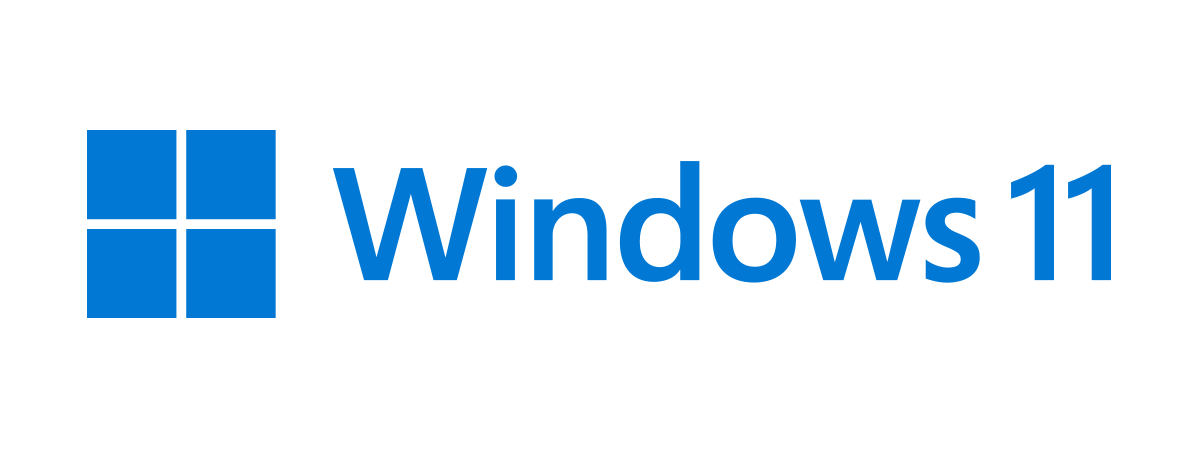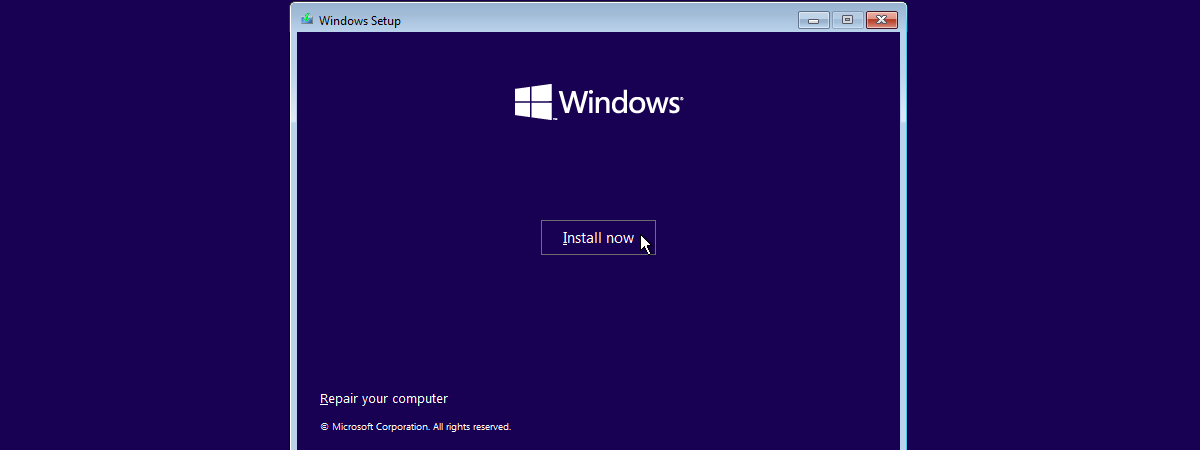
Windows 11 introduced much stricter hardware requirements than its predecessor, Windows 10, and those have also increased slightly with recent updates. As of the Windows 11 version 24H2 release (the “2024 Update”), Microsoft adjusted the minimum specs required to run this operating system. In this article, I will show you the Windows 11 minimum requirements (including the changes introduced by version 24H2), detail the Windows 11 CPU requirements and supported processors, and provide new installation requirements. Read on to learn the answers to common questions such as “Is my PC OK to run Windows 11?”, “What specs does a laptop need for Windows 11?”, or whether Windows 11 can run on an older Intel Core i5 4th Gen or 7th Gen CPU. By the end, you should also know if your PC meets the Windows 11 system requirements or what you might need to upgrade:
What are Windows 11’s system requirements?
Microsoft’s official Windows 11 minimum requirements are the baseline foundation for the hardware needed to install or upgrade to Windows 11. These apply equally to desktops and laptops, so if you’re asking “What specs does a laptop need for Windows 11?”, the answer is the same as for any PC. In summary, your device must meet all the following minimum specs:
- Processor: 1 gigahertz (GHz) or faster with two or more cores on a compatible 64-bit processor or System on a Chip (SoC). However, only certain CPUs are considered compatible. For details, check the CPU compatibility and Windows 11 processor requirements chapter in the How to manually check if your PC meets the Windows 11 system requirements section below.
- RAM: 4 gigabytes (GB) or more.
- Storage: 64 GB or larger storage device for the operating system at installation. Additional space is needed later for updates.
- System firmware: UEFI, Secure Boot capable. Legacy BIOS systems don’t meet this requirement.
- TPM: Trusted Platform Module (TPM) version 2.0 support. Most PCs from 2016 and newer should have TPM 2.0, either as a discrete chip or firmware TPM.
- Graphics card: Compatible with DirectX 12 or later with WDDM 2.0 driver.
- Display: 9-inch or larger screen, with at least 720p HD resolution (1280×720) and 8 bits per color channel.
- Internet: An internet connection and Microsoft account are required to complete the initial setup for Windows 11 Home and for Windows 11 Pro (when used for personal/home use). This means on a new installation, you must be online and sign in with a Microsoft account.
The specs above are just the minimum to run Windows 11; meeting them will allow the operating system to function, but for a smoother experience, you’ll want more powerful hardware. For example, while Windows 11’s RAM requirement is 4 GB, I’d recommend 8 GB or more for a comfortable experience, especially when it comes to multitasking. Likewise, a faster SSD and a more powerful processor with additional cores will improve performance. Some advanced apps or features may even demand more than the minimum specs.
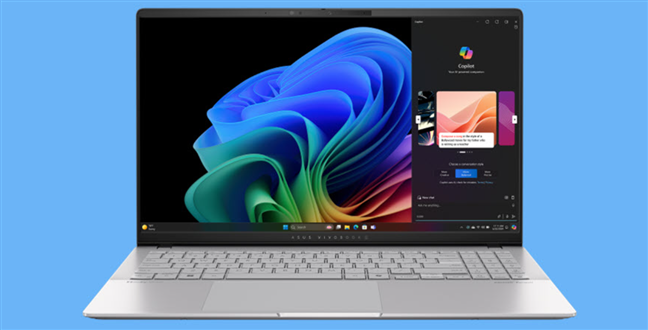
A Copilot+ PC notebook
For example, 5G mobile connectivity support requires your device to have a 5G modem, splitting your screen into three column layouts requires a screen with a width of at least 1920 pixels, Teams needs a camera, microphone, and speaker, Windows Hello demands a camera with near-infrared imaging or a fingerprint reader for biometric authentication, and the list goes on. Not to mention the most demanding of all: Copilot+ PC experiences. Features that require artificial intelligence (AI), like real-time translations and image generation, can only be run on specific hardware that includes a neural processing unit (NPU) with a capability of performing more than 40 trillion operations per second (TOPS). In addition to the baseline requirements I mentioned earlier, Copilot+ PCs must have an AMD Ryzen AI 300 series, Intel Core Ultra 200V series, or a Snapdragon X/Plus/Elite processor, as well as a minimum of 16GB of DDR5 RAM and 256GB SSD.
If you want to see each and every Windows 11 system requirement, check out Microsoft’s official Windows 11 Specs and System Requirements.
Having said all that, let’s see how you find out if your system is eligible to run Windows 11. Read the next section if you already have Windows 10 on your computer, or skip to the one after it if you want to install Windows 11 from scratch (on a PC without any operating system or with a different one than Windows 10).
Check if your Windows 10 PC meets the Windows 11 system requirements using the PC Health Check app
The fastest and easiest method to get an answer to the question on everyone’s lips - “Is my PC compatible with Windows 11?” - is to use Microsoft’s Windows 11 system requirements tool. The company calls it PC Health Check. It’s an app that looks under the hood of your computer or device and, in a second or two, tells you whether you can install Windows 11 on your PC or upgrade from Windows 10 to Windows 11.
Start by downloading the PC Health Check app and installing it on your Windows 10 PC. Once you do that, launch it, and you should see something like the screenshot below:
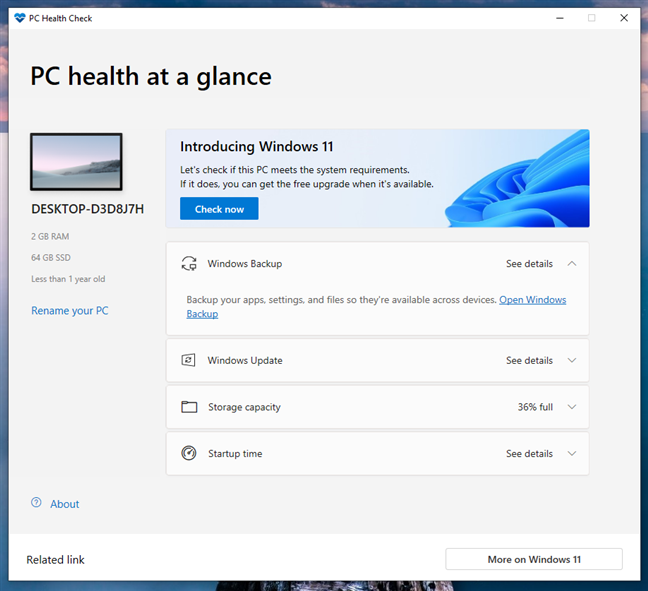
Windows 11 system requirements tool: PC Health app
In the PC Health Check window, under the Introducing Windows 11 section, click or tap the Check now button.
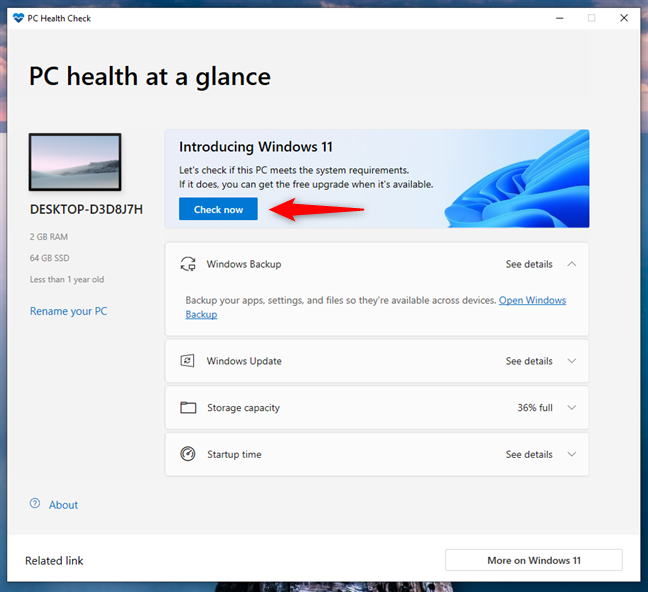
Check now if your PC meets Windows 11's system requirements
If your computer or device has the required hardware (and firmware) for Windows 11, the PC Health Check app lets you know that “This PC meets Windows 11 requirements.”
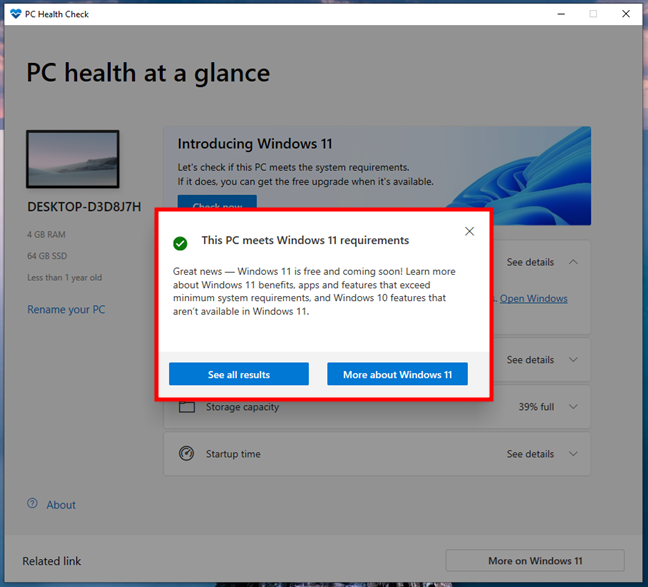
This PC meets Windows 11 requirements
If you want to see all the details, clicking or tapping See all results gives you the list of the Windows 11 system requirements that your PC meets.
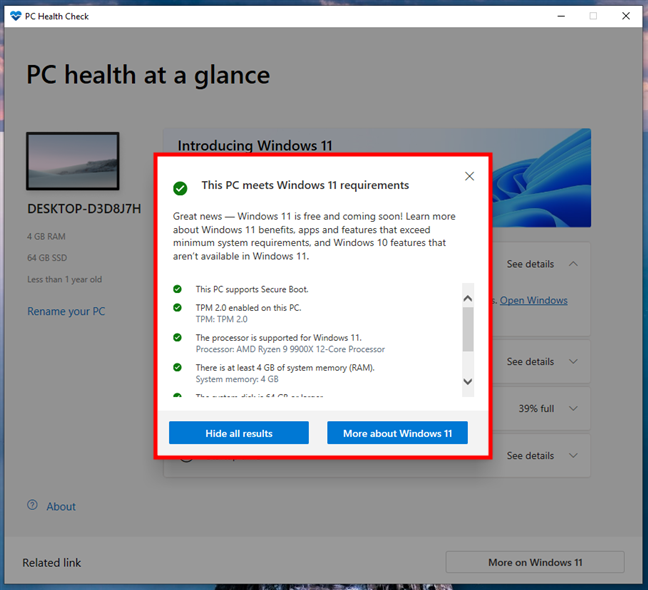
Details about the Windows 11 system requirements met by a PC
Pressing the other button, More about Windows 11, opens your default web browser and takes you to the Meet Windows 11: Features, Look, Benefits & More | Microsoft webpage, where you find out if your PC meets the Windows 11 requirements.
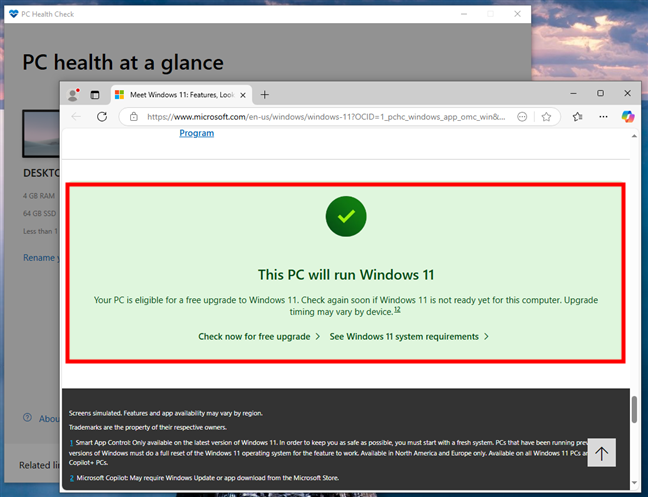
This PC will run Windows 11
TIP: If your Windows 10 computer is compatible with Windows 11, here’s how to upgrade from Windows 10 to Windows 11 for free.
In case your computer or device doesn’t currently meet Windows 11’s system requirements, the PC Health Check app notifies you and gives you a list of things you can do or change.
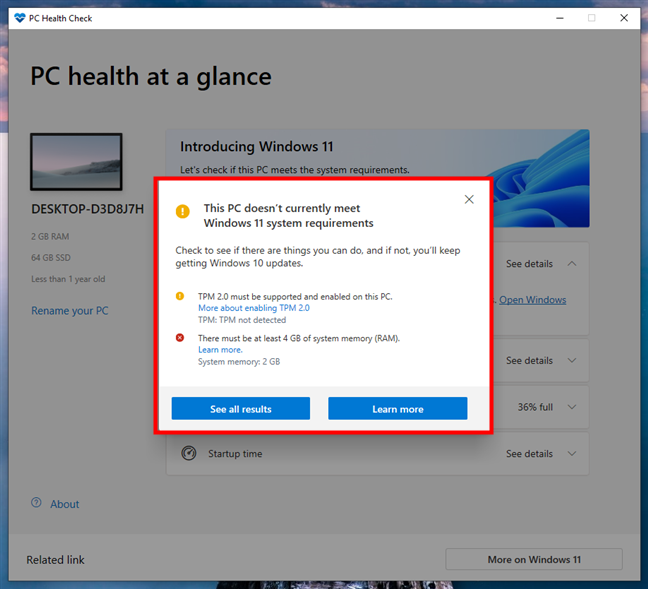
This PC doesn't currently meet the Windows 11 system requirements
In this case, too, clicking or tapping the See all results button lists all the requirements and details about each of them.
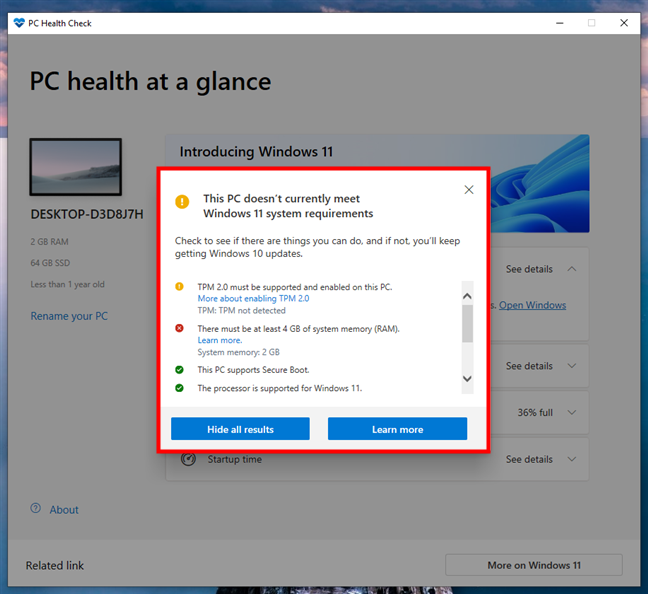
Details about the Windows 11 system requirements that aren't met by a PC
TIP: Even if your Windows 10 laptop or PC isn’t compatible with Windows 11, you can install it with a few hacks, but it may not work great. If you want to do that, read my guide on how to install Windows 11 on unsupported hardware.
How to manually check if your PC meets the Windows 11 system requirements
In the previous section of this tutorial, you’ve seen how to automatically check if a computer or device meets the system requirements for Windows 11. However, you can also do that manually by checking every system requirement on your own. If you want to know where to look, read on:
CPU compatibility and Windows 11 processor requirements
First of all, check what processor you have. To do that, launch the Task Manager in Windows 10. If it opens in its compact mode, click or tap More details. Then, switch to the Performance tab and select CPU on the left sidebar. You will see the make and model of your processor on the top right.

Windows 11 system requirements: Processor
One of the most significant (and controversial) Windows 11 requirements is the processor. Beyond the basic spec of “1 GHz, 2-core, 64-bit”, the processor must be from a supported generation. Microsoft has drawn a line in the sand at roughly late 2017 for Intel and 2018 for AMD CPUs. In other words, Windows 11 officially supports Intel 8th-generation Core processors and newer, as well as AMD Zen+ or Zen 2 Ryzen processors and newer:
- Supported Intel CPUs: 8th Gen and up. This includes Intel Core chips from the 8th Gen “Coffee Lake” family (and later 9th, 10th, 11th, 12th, 13th Gen, 14th Gen, etc.) for mainstream PCs. Intel Core 7th Gen or earlier chips are not on the supported list (with a few rare exceptions noted below). In practical terms, if you have an Intel Core i3, i5, i7, or i9 CPU from 2018 onwards, you likely meet the Windows 11 CPU requirements. But an older CPU, even one that was high-end in its day, may be unsupported. For example, an Intel Core i5 4th Gen (from 2014) does not meet the Windows 11 CPU requirement. Even a Core i5 7th Gen (from 2017) is not officially supported. Microsoft’s compatibility list explicitly excludes most 7th Gen and older Intel processors. The only supported 7th-gen Intel CPUs are a few specific models that Microsoft added by exception: notably, the Intel Core i7-7820HQ (a 7th-Gen mobile chip used in devices like the Surface Studio 2) and certain Intel Core X-series and Xeon W-series chips from that era. But if you have a typical 7th-Gen Core i5 or i7 consumer CPU, it’s unsupported for Windows 11.
- Supported AMD CPUs: “Zen+” and up. Windows 11 requires an AMD processor from the late-2018 era or newer. This translates to AMD Ryzen 2000 series or later, as well as newer Athlon and EPYC CPUs. First-generation AMD Ryzen 1000 series (2017) are not supported, nor are older AMD FX or A-series processors. In short, if your AMD CPU is from the Ryzen 2000, 3000, 4000, 5000, 7000, 9000 series (or newer), you’re fine, but an original Ryzen 7 1700 or an old AMD Phenom II, for instance, would not be. AMD APUs like the Athlon 3000G and newer Athlon Gold/Silver chips are supported as they are from the same Zen2/Ryzen 3000 era.
- Supported Qualcomm/ARM CPUs: Windows 11 on ARM supports Qualcomm Snapdragon 7c, 8c, 8cx, and Microsoft SQ-series SoCs used in ARM-based Windows devices. If you have a Windows on ARM laptop or tablet, ensure it has an ARM v8.1-based SoC or newer (ARM v8.0 is no longer supported in 24H2).
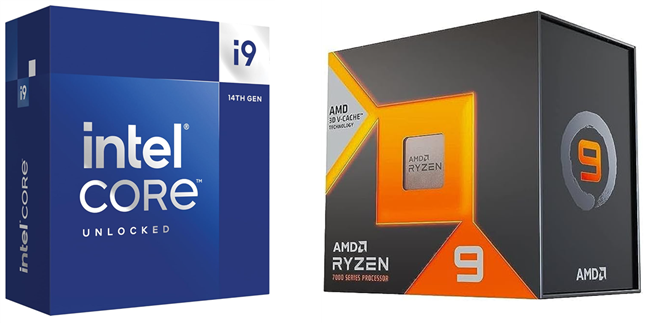
AMD vs Intel
In summary, the official CPU compatibility lists for Windows 11 encompass relatively recent processor models: roughly the past 5-6 years of mainstream CPUs. Microsoft provides full lists of supported processors on their site (there are separate lists for Intel, AMD, and Qualcomm models, all available here: Windows Processor Requirements). If your CPU is on the supported list, that satisfies the CPU requirement. If it’s not on the list (e.g., a 4th-Gen or 7th-Gen Intel Core, or a 1st-gen Ryzen), the Windows 11 setup will generally tell you it’s unsupported, even if the chip technically meets the 1 GHz/2-core baseline. Many users specifically ask, “Can Windows 11 run on an i5 4th Gen?” or “...on an i5 7th Gen?” The official answer is no, those CPUs are not supported by Windows 11. Only chips roughly equivalent to Intel 8th-Gen/Core i3-8100, Core i5-8400, Core i7-8700 or newer (and AMD Ryzen 2000-series or newer) are officially OK for Windows 11.
Windows 11 24H2: New CPU requirements and changes
With the release of Windows 11 version 24H2 (the 2024 update), Microsoft made a few adjustments to the requirements, though the base hardware specs remain the same. If your PC already runs Windows 11, it likely can run 24H2 just fine, as the core requirements (CPU family, TPM 2.0, RAM, etc.) are unchanged for standard editions. For example, an 8th-gen Intel or Ryzen 3000 system that was Windows 11-compatible from the start is still compatible with 24H2. Despite some news suggesting 24H2 might raise the CPU requirement to 11th-gen Intel, Microsoft clarified that 8th, 9th, and 10th-gen Intel Core processors remain supported in 24H2. In other words, PCs that met Windows 11’s initial CPU cut-off are not being dropped in this update.

Microsoft clarification regarding the Intel processors supported by Windows 11
However, Windows 11 24H2 did introduce some behind-the-scenes changes: notably, it now requires certain modern CPU instructions (support for SSE4.2 and POPCNT) for the OS to boot in specific scenarios. Practically, this affects only very old CPUs that lack those instructions and only if you’re bypassing the TPM 2.0 requirement. All officially supported CPUs already have SSE4.2/POPCNT, so regular Windows 11 users won’t notice this change. But it means that if someone tried to force-install Windows 11 24H2 on an extremely old 64-bit processor (one from the late 2000s that doesn’t support SSE4.2), the 24H2 kernel would refuse to boot. Earlier Windows 11 versions might have run (unsupported) on such a chip, but 24H2 enforces a stricter requirement in this regard. The above change is not an issue for most users: if your system meets the normal Windows 11 requirements, it supports those instructions, too.
To make things as clear as possible, Microsoft also published and regularly updates lists of Windows 11 compatible processors. Depending on who made your processor, you can check whether your CPU is OK for Windows 11 here:
- Windows 11 version 24H2 supported AMD processors
- Windows 11 version 24H2 supported Intel processors
- Windows 11 version 24H2 supported Qualcomm processors
How to check if your PC meets Windows 11’s RAM requirements
Secondly, we’ve encountered people asking questions like “Can Windows 11 run on 2GB RAM?”. The answer is no; you need to have four or more gigabytes of RAM. And that’s easy to check in Windows 10 using Task Manager. In its Performance tab, select Memory on the left sidebar. Then, look at the top-right corner of the window. There, you can see how much RAM your PC has.
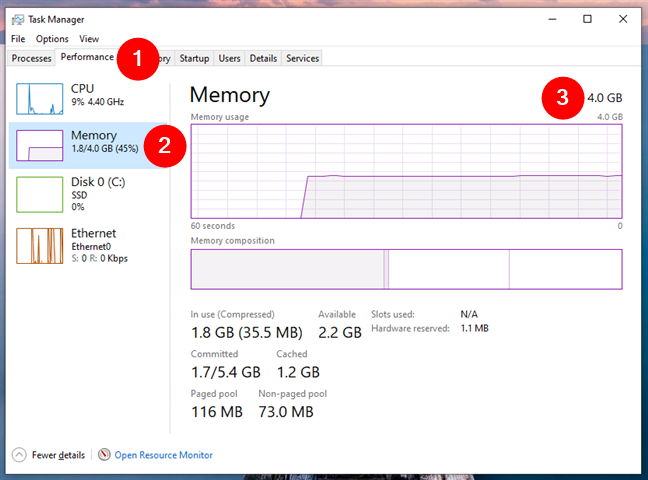
Windows 11 system requirements: RAM
Does your PC meet Windows 11’s minimum storage requirements?
Windows 11 needs at least 64 GB of storage space, which shouldn’t be a problem for most computers these days. However, to make sure you do have it, open File Explorer, select This PC, and check what it tells you about your C: drive (where Windows 10 is usually installed). If it has a total capacity of at least 64 GB, it meets Windows 11’s system requirements. If it doesn’t, you might want to try repartitioning your hard disk or solid-state drive to increase C’s size.
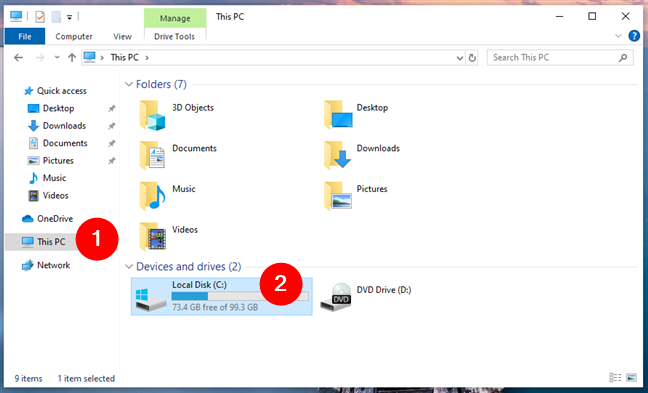
Windows 11 system requirements: Storage
What about Windows 11’s graphics card requirements?
One other Windows 11 system requirement is that your graphics card is compatible with DirectX 12 and has a WDDM 2.0 driver (or newer). Fortunately, verifying whether your GPU is enough for Windows 11 is quite easy:
Open the DirectX Diagnostic Tool and check the DirectX Version entry at the bottom of the System tab. If it displays DirectX 12, you’ve met one of the GPU requirements.
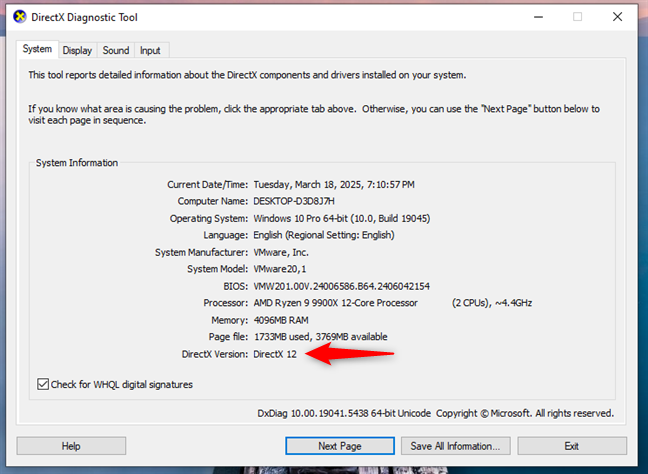
Windows 11 system requirements: GPU that supports DirectX 12
Then, switch to the Display tab from the DirectX Diagnostic Tool. In the Drivers section on the right side of the window, look for the Driver Model. If it displays WDDM 2.0 or higher, your GPU also meets the second Windows 11 system requirement.
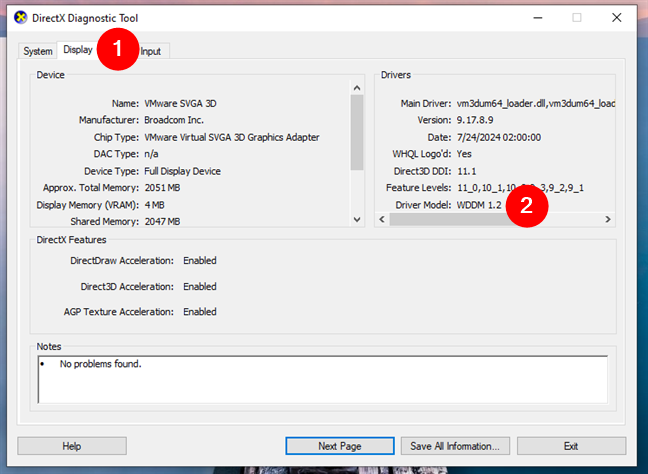
Windows 11 system requirements: GPU with a WDDM driver 2.0 or higher
How to see if your PC uses UEFI
You can’t upgrade to Windows 11 if your PC uses an old, legacy BIOS. It has to have UEFI (Unified Extensible Firmware Interface). To check that in Windows 10, open the System Information tool. Then, look through the System Summary to find the BIOS Mode information. If it displays UEFI, then your PC meets Windows 11’s UEFI system requirement.
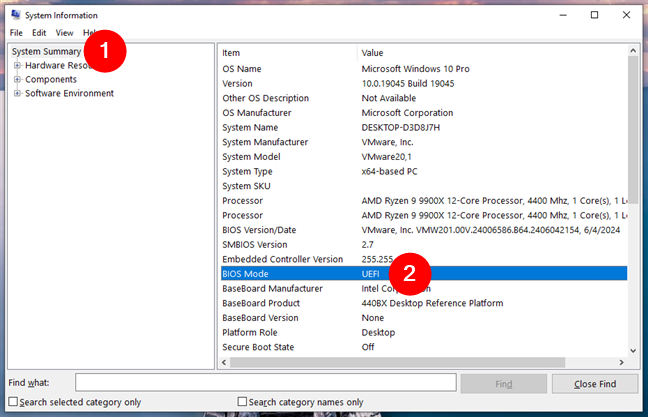
Windows 11 system requirements: UEFI (not BIOS)
How do I check if my PC has a TPM (Trusted Platform Module) version 2.0 chip?
As you already know, Windows 11 also requires a TPM version 2.0 chip to be able to run. The easiest way to check whether you have one and that it’s enabled is to see if it’s shown in Device Manager. Open Device Manager, look for Security devices, and expand it. If it lists a Trusted Platform Module 2.0, then your PC covers this Windows 11 system requirement.

Windows 11 system requirements: TPM 2.0
However, there are many computers and devices out there that do have TPM 2.0, but it’s not enabled by default in their UEFI. So, even if Device Manager doesn’t show it, it doesn’t necessarily mean you don’t have TPM 2.0. To make sure, you should access your PC’s UEFI and browse through its pages to see if you can find a setting called TPM, Trusted Platform Module, PTT (Intel Platform Trust Technology), or fTPM (Firmware TPM).
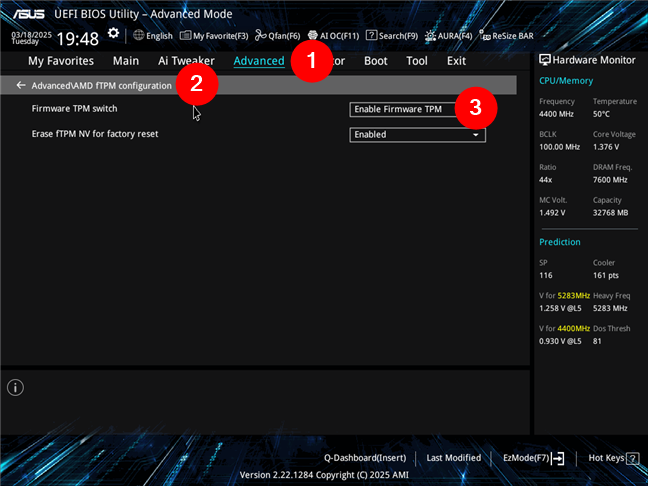
Enabling AMD Firmware TPM on an ASUS motherboard
If you do, make sure you enable it, save your new settings, and restart your PC. Then, once Windows 10 is up and running, check again for what Device Manager has to say about TPM, as you might be in luck.
Can your PC run Windows 11?
Most PCs sold in the last few years meet the Windows 11 system requirements, but it’s always best to check beforehand. Use the compatibility checker or the list above to see if your CPU, RAM, storage, and security features are up to par for Windows 11. If your device meets these Windows 11 requirements, then the answer to the question “Is my PC OK to run Windows 11?” is yes, and you can enjoy Microsoft’s latest operating system (including the newest features in version 24H2) with full support. If not, you’ll need to either upgrade your hardware or stick with a supported OS for a bit longer (or accept the risks of an unsupported installation). Having said that, you should now know what Windows 11 expects from your PC and whether it’s time for an upgrade or you’re ready to install and enjoy Windows 11.


 27.03.2025
27.03.2025 
